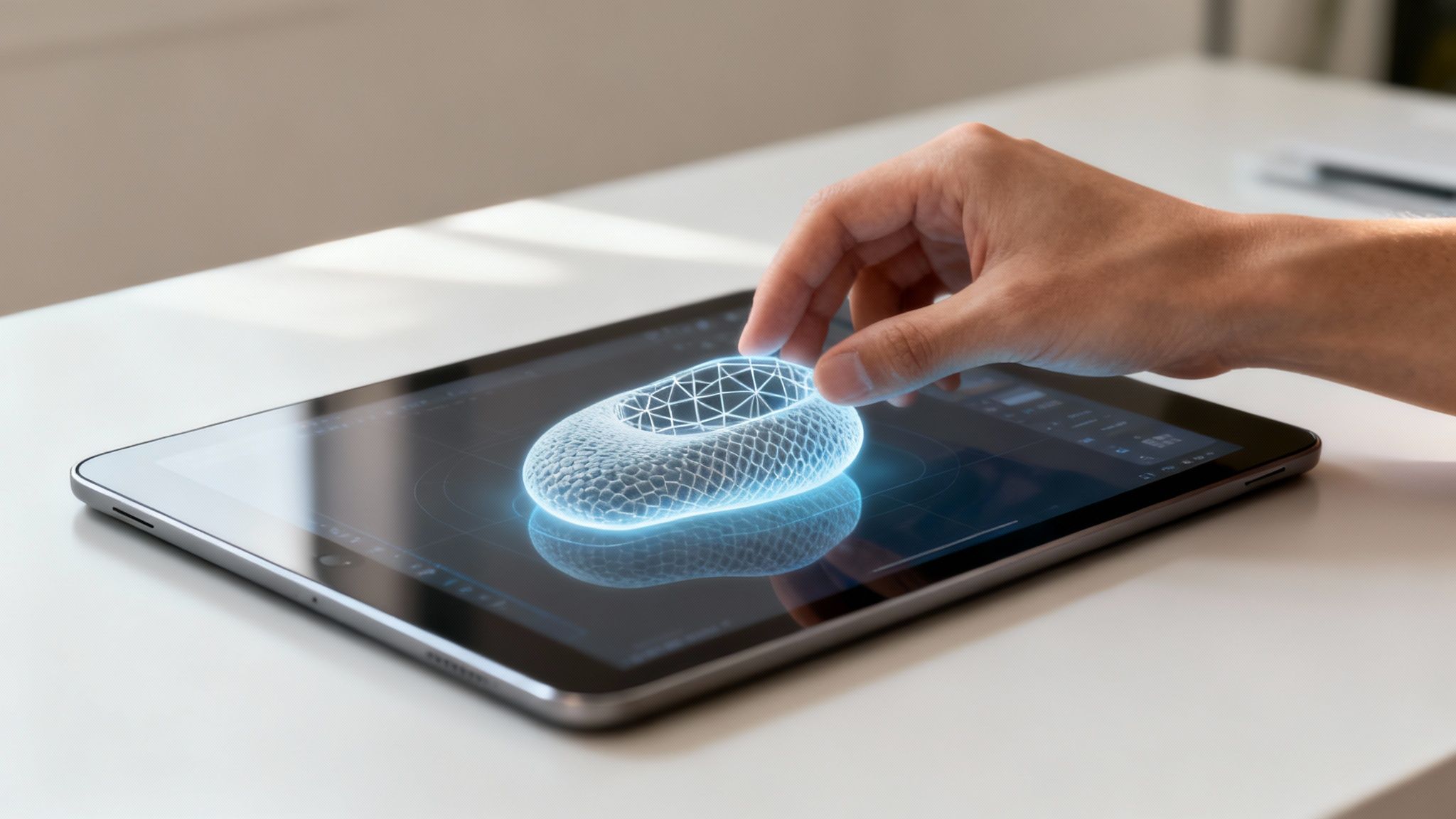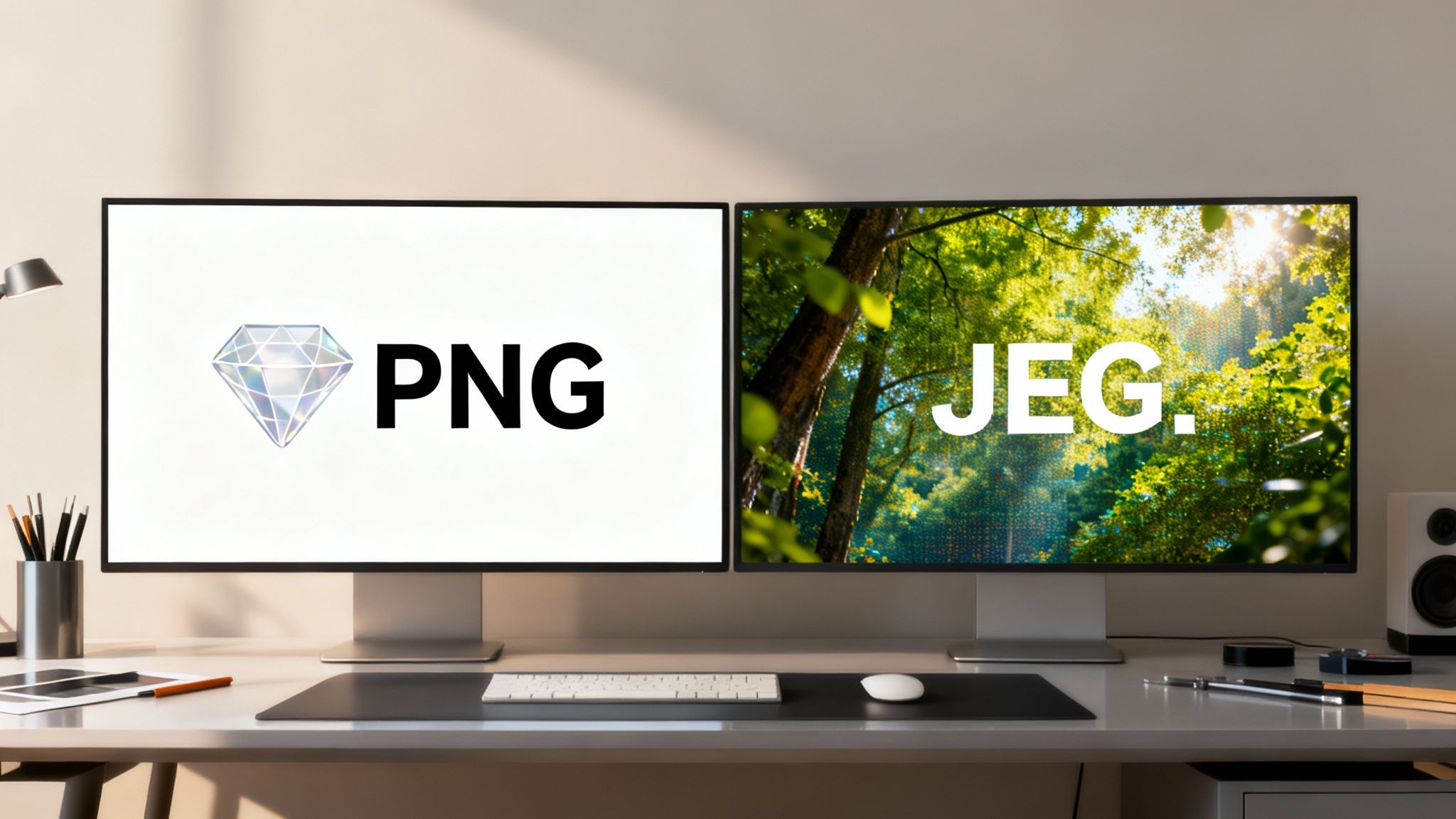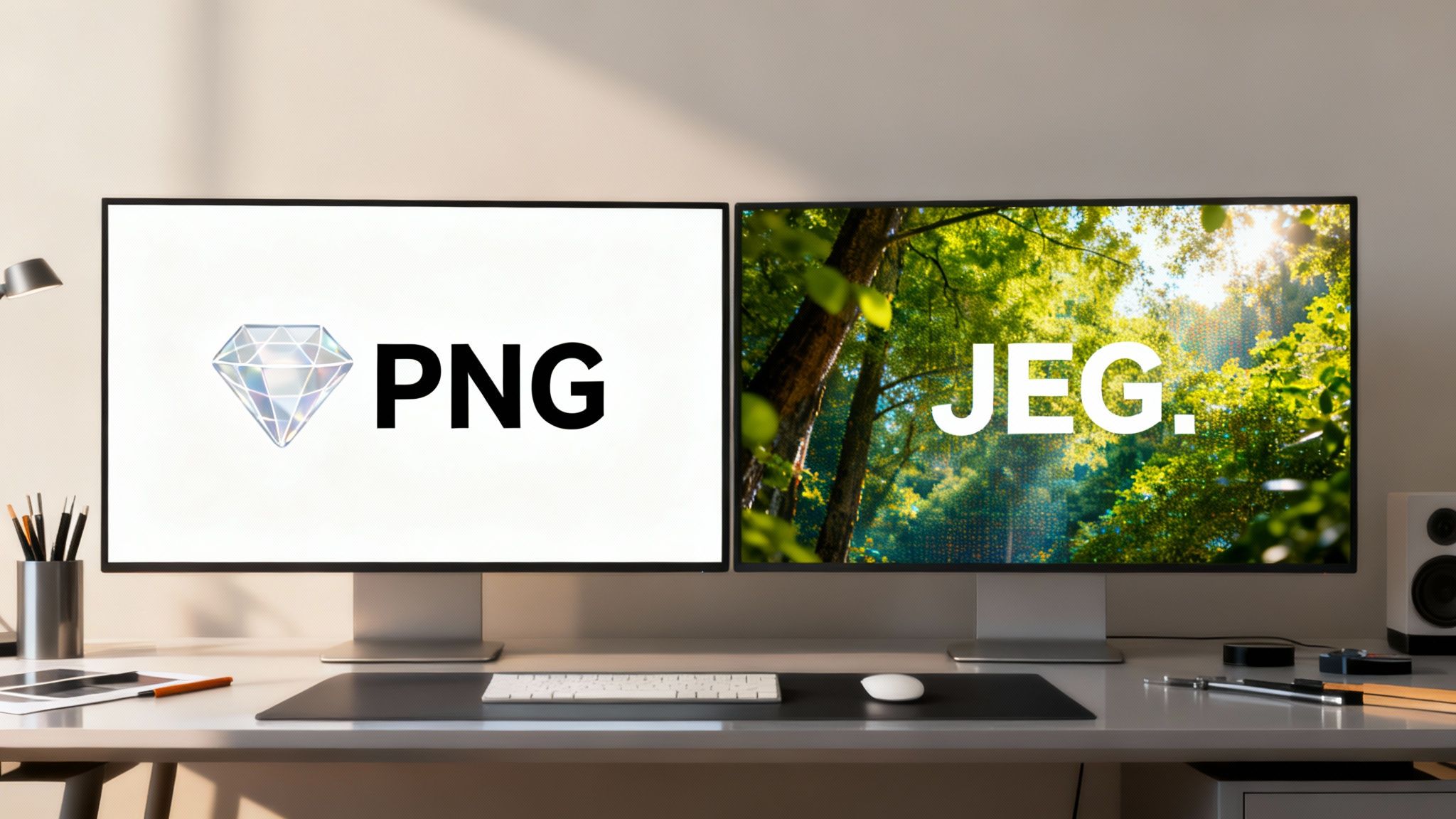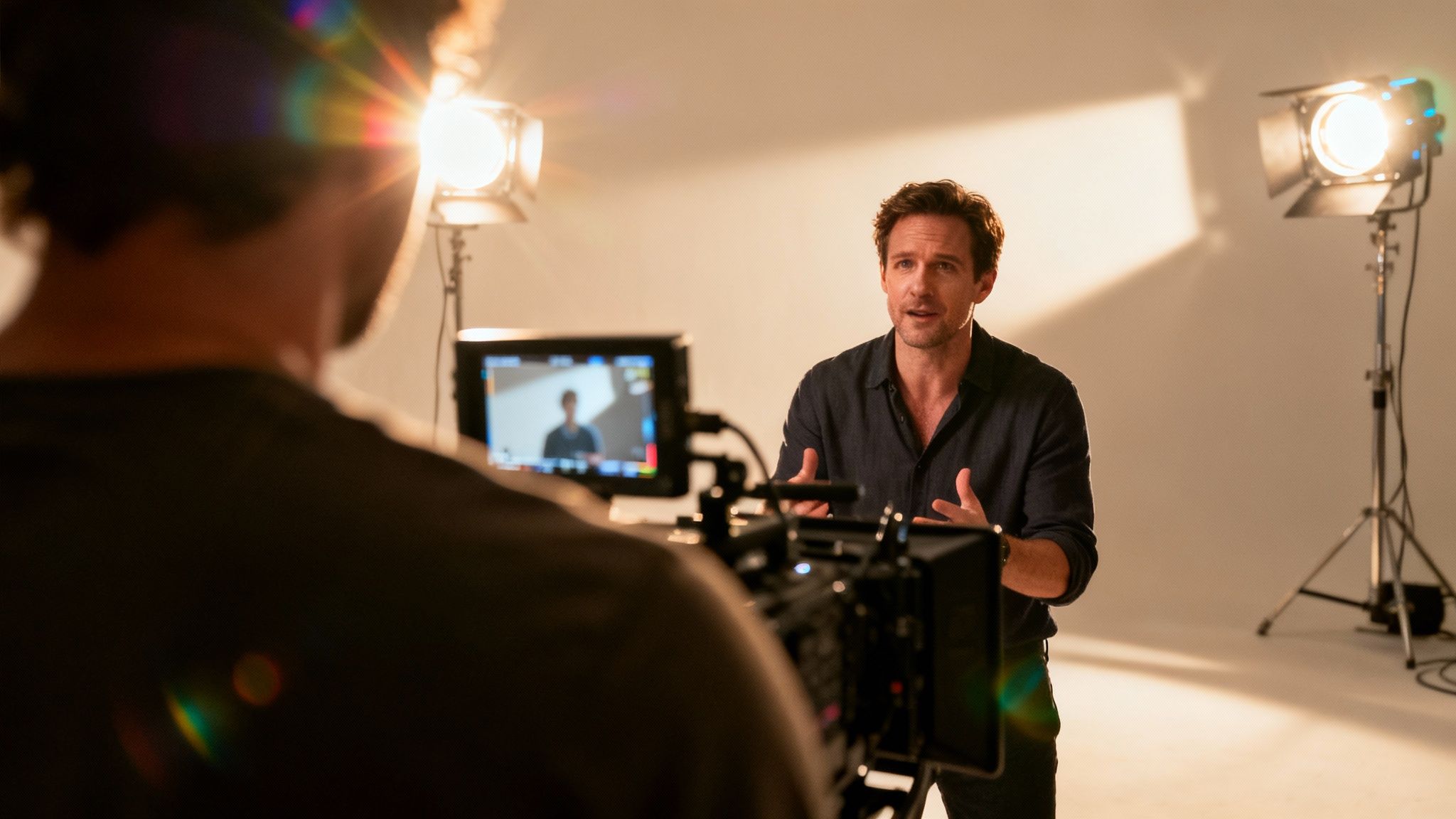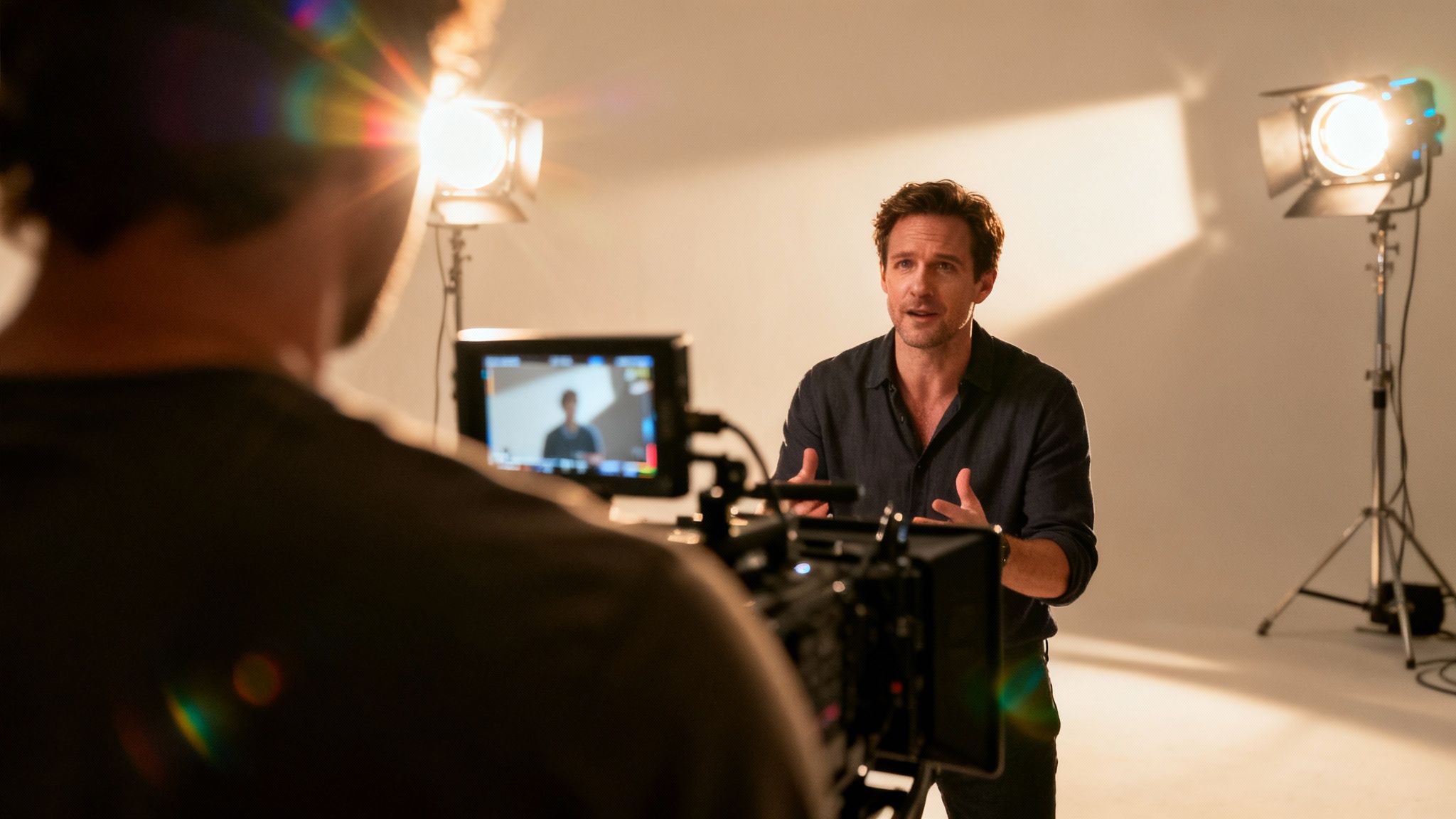Historically, creating a 3D model from scratch was a significant investment of time and resources, often involving painstaking manual work. This paradigm is shifting rapidly. Today, AI enables the generation of detailed 3D assets from simple text prompts or images, allowing design teams to prototype concepts more efficiently than ever before.
The New Reality of 3D Asset Creation
Welcome to the next era of digital design. The ability to generate 3D models with AI is no longer a future concept—it is a practical tool that is already reshaping professional workflows. This shift is lowering the traditional barriers to entry, which often included deep technical expertise and substantial time commitments.
Now, artists, designers, and enterprise teams can bring ideas to life with remarkable speed. Platforms like Virtuall allow users to transform a simple text description or a reference image into a detailed 3D object. This capability accelerates every stage of the creative pipeline, from initial brainstorming to final product delivery.
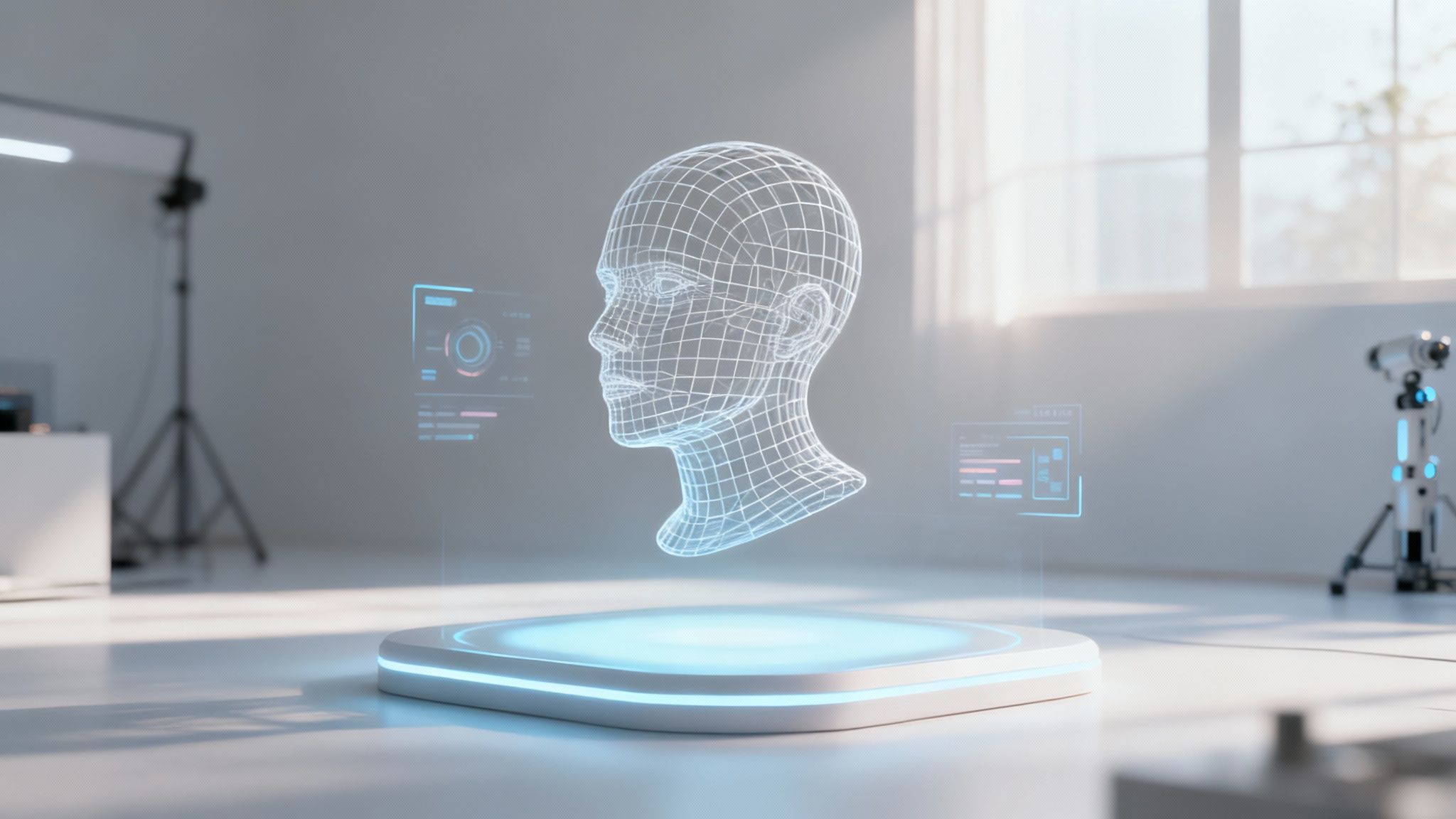
Unlocking New Creative Possibilities
The value of this technology extends beyond speed; it opens up entirely new avenues for creation. The global 3D modeling market is experiencing significant expansion, projected to reach $3.364 billion by 2025—a notable increase from its $1.916 billion valuation in 2021. This reflects a compound annual growth rate of over 15%.
This growth is driven by the demand for more efficient content creation methods. AI tools are well-positioned to meet this demand by offering:
- Rapid Iteration: Generate numerous variations of a model in minutes, not days. This allows for greater creative exploration without the manual effort.
- Accessibility for All Skill Levels: Junior designers and other team members can create foundational assets. This frees senior modelers to focus on complex, high-value tasks.
- Streamlined Prototyping: Whether visualizing a new product, a game asset, or an architectural concept, AI allows for the rapid creation of tangible models for stakeholder review, validating ideas before committing significant resources to development.
A practical application of this can be seen in this guide to AI furniture design. It serves as an excellent example of how AI can generate and refine tangible, complex designs from simple text inputs.
This comparison highlights the fundamental shift in the creative process. AI handles much of the initial groundwork, allowing your team to focus on refinement and innovation.
AI Generation vs Traditional 3D Modeling
StageAI-Powered GenerationTraditional 3D ModelingConceptInstant visualization from a prompt or image.Manual sketching, mood boards, and concept art.Initial ModelGenerated automatically in minutes.Hours or days of block-outs and basic sculpting.IterationGenerate countless variations instantly.Each change is a manual, time-consuming edit.Skill RequirementEffective prompt writing and creative direction.Deep expertise in software like Blender, Maya, ZBrush.SpeedFrom idea to usable asset in under 5 minutes.Can take days or weeks for a single complex asset.
While traditional methods continue to offer granular control for highly specialized work, AI generation significantly lowers the barrier to entry and accelerates the entire process.
Consider this technology a creative co-pilot. It manages the initial, often repetitive, part of asset creation. This allows your team to dedicate their energy to the artistic details that make a project stand out, all within a secure, enterprise-grade environment.
Ultimately, the goal is to integrate AI into the creative process seamlessly. You can learn more about how AI 3D model generation is becoming an indispensable tool for modern creative teams. The result is less time spent on repetitive tasks and more time dedicated to realizing your creative vision.
Crafting Prompts That Deliver Results
The quality of any AI-generated asset depends on the clarity of your instructions. To obtain the 3D model you envision, it is essential to communicate that vision in a language the AI can interpret. This involves moving beyond simple keywords and embracing the art of specificity.
Consider it analogous to commissioning an artist. A vague request like "make a sci-fi crate" leaves too much room for interpretation. You will receive a result, but it may not align with your specific requirements.
Instead, construct a detailed picture with your words. A more effective prompt would be: "A weathered, metallic sci-fi cargo crate with glowing blue hexagonal panels and rusted edges, photorealistic style." This version provides the AI with crucial details regarding material, condition, specific features, and the desired aesthetic. Each adjective serves as a guidepost, dramatically improving the final output.
From Vague Ideas to Tangible Assets
The difference between a generic and a specific prompt is the difference between a rough concept and a usable asset. Your objective is to eliminate ambiguity.
When writing a text prompt, aim to cover these elements:
- Subject: What is the primary object? (e.g., "an ornate armchair")
- Material: What is it made of? (e.g., "carved dark mahogany wood, velvet upholstery")
- Style: What artistic or historical aesthetic are you aiming for? (e.g., "Victorian-era, gothic revival")
- Details: What are the unique features? (e.g., "with claw-foot legs and intricate floral carvings")
- Atmosphere: What is the overall mood or lighting? (e.g., "dramatic, low-key lighting")
This structured approach transforms a simple idea into a rich, detailed instruction set. For a deeper understanding of this crucial skill, consider this a guide to modern prompt engineering.
Using Images as a Starting Point
When you generate a 3D model from an image, the quality of your source material is as critical as a well-written prompt. The AI requires clear visual data to produce an accurate model. A blurry, poorly lit photograph will likely result in a distorted or imprecise model.
To achieve optimal results, select source images that feature:
- Clear, Even Lighting: Avoid harsh shadows or overexposed highlights that obscure the object’s form.
- High Contrast: The subject should be clearly distinguishable from its background.
- A Single, Defined Subject: An image of one object from a clean angle is easier for the AI to interpret than a cluttered scene.
Think of your prompt as the blueprint for your 3D model. Whether using text or an image, providing the AI with a clear, detailed, and unambiguous blueprint is the most effective way to ensure the final result aligns with your creative vision.
By mastering this input stage, you can avoid common frustrations and begin achieving impressive results from your initial attempts. For a closer look at the technology behind this process, you may find our guide on turning text to 3D models informative.
Your First AI-Powered 3D Model Generation
With a well-defined prompt, you are ready to begin the creation process. This is where we transition from theory to practice within the Virtuall platform. The workspace is designed to be intuitive, enabling the conversion of your text or image into a 3D asset without the steep learning curve associated with traditional software.
Let's consider a practical scenario. An architectural visualization artist needs a specific piece of furniture—a minimalist oak armchair with clean lines and charcoal gray fabric cushions. Instead of dedicating a full day to modeling it manually, it can be generated in minutes.
This illustrates the basic workflow: a detailed text input leads directly to a high-quality 3D asset.
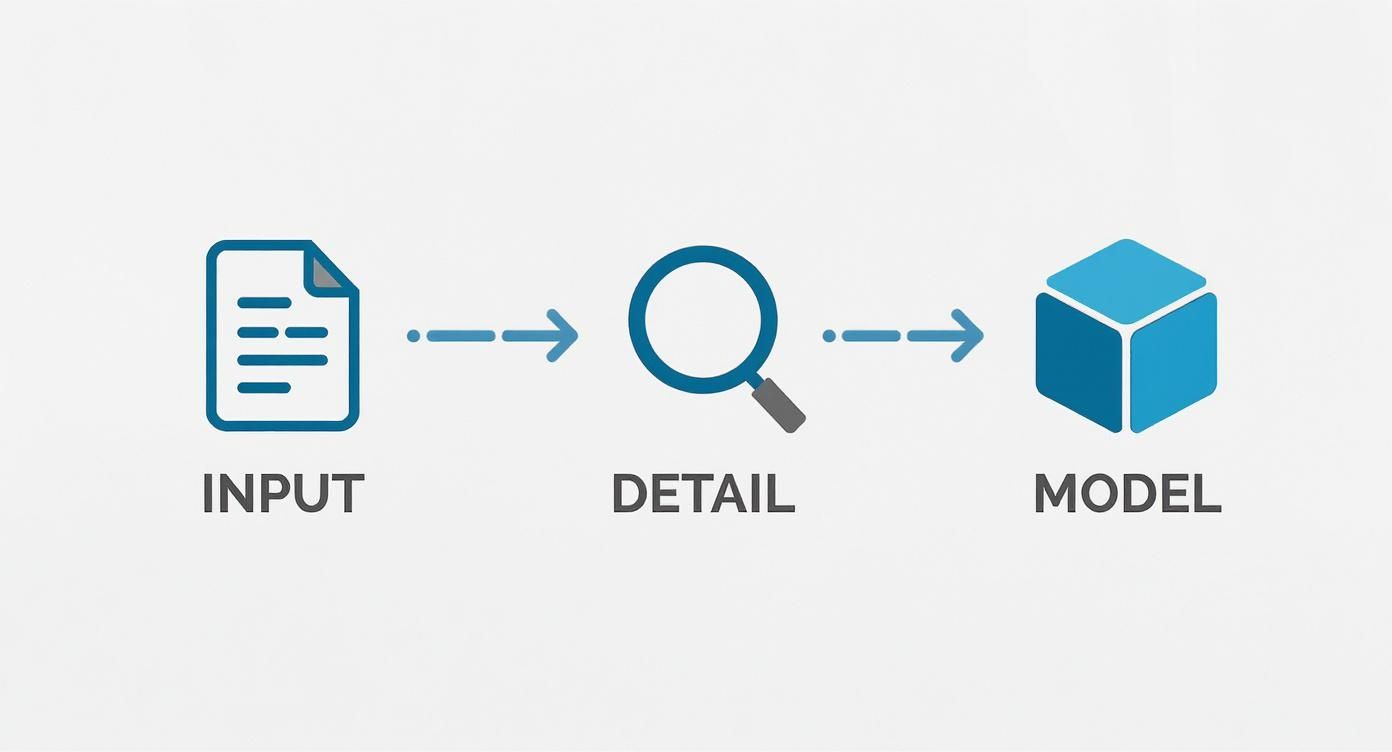
The quality of the input directly influences the quality of the output.
Navigating the Generation Interface
Inside the Virtuall workspace, you will find a clean and efficient interface. The primary tool is the generation panel, where you will input your prompt and adjust key parameters to guide the AI.
You will paste your prompt—"A minimalist oak armchair with clean lines and charcoal gray fabric cushions, photorealistic style"—into the main text field. From there, you have several options to refine the result:
- Style Influence: This slider determines how strictly the AI adheres to a specific aesthetic. For our armchair, you would set it toward "photorealistic."
- Detail Level: This controls the geometric complexity of the mesh. A higher setting is ideal for hero assets or close-up shots where detail is crucial.
- Seed Number: This feature allows you to regenerate a similar model repeatedly, which is useful for creating consistent variations on a theme.
After setting your parameters, click "Generate" and allow the platform to process your request.
What’s Happening Behind the Scenes?
During the generation process, the AI is not simply retrieving a pre-made model from a library. It is constructing one from the ground up based on its training data. It deconstructs your prompt—interpreting keywords like "oak," "fabric," and "minimalist"—and connects them to a vast dataset of visual information.
First, it builds the model’s geometry (the mesh). Then, it creates the corresponding textures, such as the wood grain and fabric weave. This entire process, which traditionally took a skilled artist days to complete, now occurs in minutes. Recent advancements even allow AI to generate scenes with physical consistency for several minutes at a time, representing a significant leap forward.
The initial generation serves as your foundation. It is a high-quality first draft that captures your core idea, ready for refinement and integration into your professional pipeline.
This ability to quickly generate 3d model assets is fundamentally changing how creative work is accomplished. It is more than a time-saving measure; it is a powerful partner for creative exploration. To see what other tools are available, explore our deep dive into the best AI tools for 3D modeling.
Refining and Iterating on Your 3D Model
The initial AI-generated model should be viewed as a high-quality starting point, not a finished product. The real value is realized in the post-generation workflow, where you transform the raw asset into something polished and production-ready.
The initial output is designed to be a solid foundation. It may have minor mesh artifacts or textures that require refinement, which is an expected part of the process. The Virtuall platform includes built-in tools for this phase, allowing you to clean, enhance, and prepare your model for any professional pipeline within a single workspace.
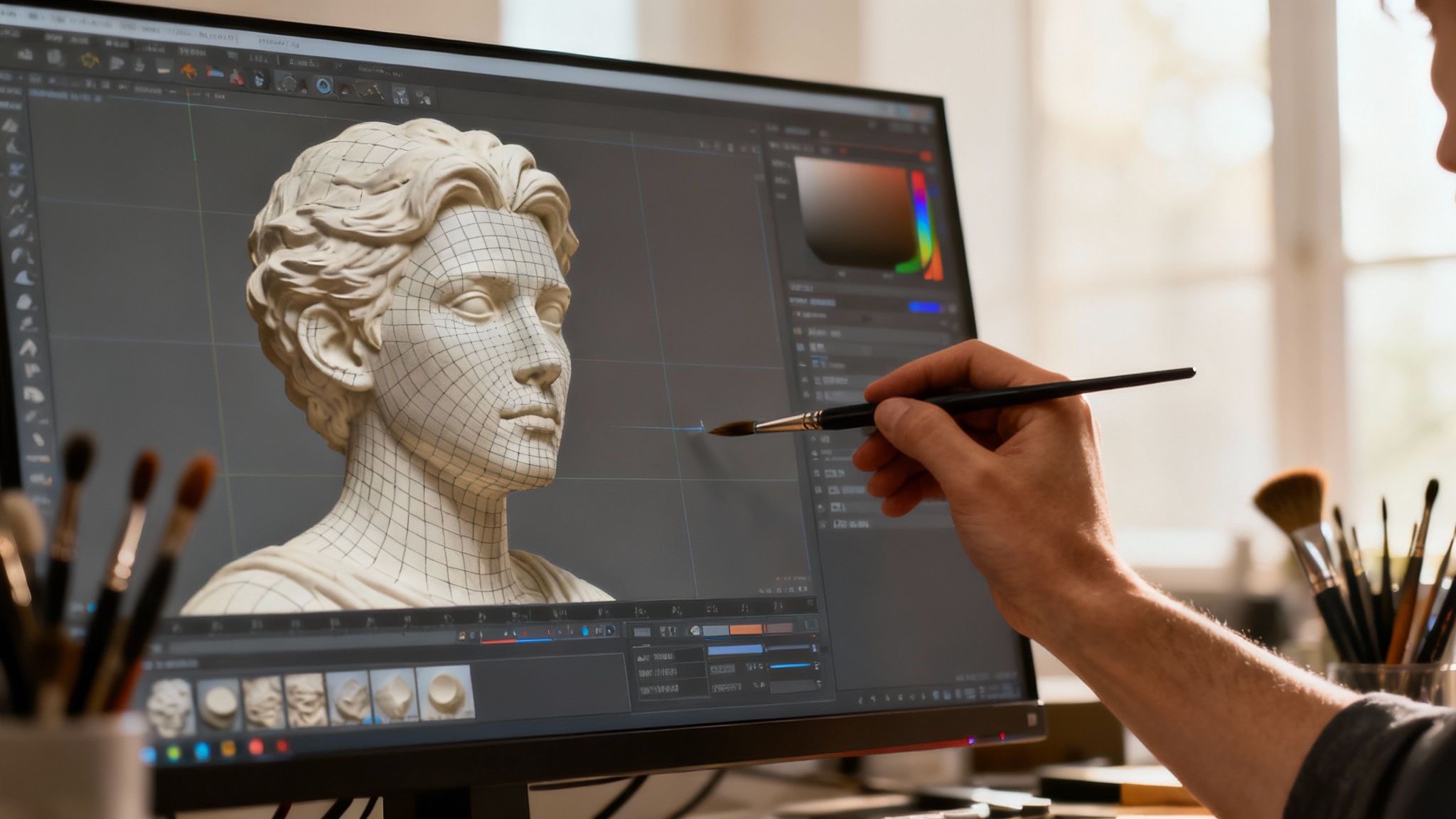
From Raw Asset to Animation-Ready Character
Let's walk through a common scenario: you've generated a character model for an animation project. The AI has provided a strong base, but now you must ensure it is technically sound and meets your project's specific requirements.
Here is a typical post-generation checklist:
- Mesh Cleanup: The first step is to inspect for stray vertices, non-manifold geometry, or intersecting polygons. Virtuall’s integrated sculpting and cleanup tools allow for smoothing rough areas and correcting imperfections directly on the model.
- Topology Review: For animation, clean edge flow is essential. While AI is improving in this area, you will likely want to use retopology tools to optimize the mesh for deformation. Proper topology ensures a character moves naturally.
- Texture Enhancement: The AI-generated textures serve as an excellent base. You can use painting tools to add finer details—such as scuffs on armor or subtle variations in skin tone—that enhance the character's narrative.
Once these adjustments are complete, the final step is exporting the asset. Virtuall supports standard formats like .fbx, ensuring the model, its textures, and any rigging information are correctly packaged for use in tools like Blender, Maya, or your chosen game engine.
This iterative process is becoming standard practice. The 3D modeling software market was valued at approximately $33.3 billion USD and is projected to reach roughly $35.9 billion by 2025. New tools using generative AI have already reduced asset creation time by up to 35%, demonstrating its significant role in professional workflows. You can explore these 3D modeling market trends for more insight.
Using AI as an Iterative Partner
Refinement involves more than manual fixes; it also means leveraging AI as a creative partner. Iteration is a key component of this partnership.
Instead of starting from scratch each time, you can feed your refined model back into the AI to explore new creative directions.
Iteration is where innovation happens. By feeding a modified asset back into the generation engine, you can explore variations you might not have otherwise considered, turning a single concept into a dozen possibilities.
For example, take your refined character model and use a new prompt like, "Add ornate, sci-fi shoulder pauldrons with glowing blue circuits." The AI will use your existing model as a base and generate variations incorporating the new elements.
This approach allows for rapid prototyping of complex additions and continuous improvement. It transforms the process to generate 3d model assets into a dynamic, collaborative exchange with the AI.
Secure Collaboration for Creative Teams
In an enterprise environment, creating a 3D model is typically a collaborative effort involving artists, project managers, and clients. Traditional communication methods like email chains and scattered feedback are often inefficient.
A unified platform centralizes this process within a controlled environment designed for creative production. Virtuall was developed to manage this entire collaborative loop securely. It serves as a central hub for sharing assets, providing feedback, and tracking versions, ensuring all stakeholders are aligned without compromising security. This is particularly important when handling proprietary designs and confidential intellectual property.
The shift to cloud-based teamwork is a significant driver of growth in creative technology. By 2025, the global 3D mapping and modeling market is projected to reach approximately $8.58 billion. Software represents the largest segment, accounting for 45.29% of revenue, largely due to innovations in AI and collaborative workflows. You can see how collaborative software is shaping the 3D industry on mordorintelligence.com.
Managing Access and Protecting IP
Protecting intellectual property is a primary concern for any creative enterprise. When multiple individuals are involved with a 3D asset, it is crucial to have strict control over permissions.
Within a shared workspace, you can assign specific roles to manage access effectively:
- Viewers: Can see models and read comments but cannot make changes or download files. This role is suitable for stakeholders or clients who need to monitor progress.
- Commenters: Can add annotations directly onto the 3D model, keeping all feedback in context and tied to the specific asset.
- Editors: Have full permission to generate 3d model iterations, modify existing models, and upload new versions. This role is typically reserved for the core creative team.
- Admins: Control project settings, manage user access, and oversee the entire workspace.
This tiered system ensures that sensitive designs are accessed and modified only by authorized personnel at the appropriate times.
For enterprise teams, security is not just a feature—it is the foundation of the creative process. Effective collaboration requires confidence that all work is protected and every change is tracked.
Maintaining a Clear Version History
Creative work is inherently iterative. When you generate 3d model assets with AI, you may produce dozens of versions before arriving at the final one. Without a clear version history, this process can become disorganized, leading to lost work and confusion.
Virtuall automatically tracks every iteration of an asset. This allows you to easily compare different versions, revert to an earlier stage if a new direction is not working, and see a complete audit trail of who made changes and when. This level of transparency is essential for keeping projects on schedule and enabling teams to leverage AI effectively without losing control.
Your Questions About AI 3D, Answered
Adopting AI for your 3D workflow will naturally raise questions. It is a rapidly evolving field, and understanding the technology's capabilities and limitations is key to successful implementation.
Let's address some of the most common questions from creative teams who are beginning to generate 3d model assets with AI.
What File Formats Can I Export?
Compatibility is a critical consideration. You need assurance that the assets you create will integrate seamlessly with your team's existing tools.
Platforms like Virtuall support industry-standard formats. You can export your models as:
- .obj: A widely supported format, ideal for static models.
- .fbx: The standard for animation, games, and VFX, bundling the mesh, textures, lighting, and animation data into a single file.
- .gltf: A modern, efficient format designed for web and real-time applications, often called the "JPEG of 3D."
This ensures that your AI-generated assets are ready for use in applications like Blender, Maya, and 3ds Max, as well as game engines such as Unity and Unreal Engine.
Who Owns the IP of Generated Models?
This is a crucial question for any commercial project. The answer must be unambiguous.
When you use a secure, enterprise-ready platform like Virtuall, the intellectual property of the 3D models you generate belongs to you. The platform is the tool; the creation is your property.
Your proprietary designs, prompts, and final assets remain completely confidential and under your control. For any serious creative work, this is a fundamental requirement that protects your unique ideas and business interests.
This clear ownership model allows your team to innovate freely without concerns about future IP complications.
How Complex Can the Models Get?
The potential for complexity is already substantial and continues to grow. You can generate 3d model assets for a wide range of applications, from simple props to intricate character concepts and detailed architectural elements.
The complexity of the result largely depends on two factors: the capabilities of the AI model and the detail provided in your prompt.
A well-crafted, descriptive prompt is essential for guiding the AI toward the desired level of complexity. While the results can be incredibly detailed, your most critical "hero" assets will likely benefit from a final review and refinement by a human artist using traditional 3D software.
This combination of AI-driven speed and human oversight is how polished, production-ready models are created.
Ready to see how AI can enhance your team’s creative workflow? Virtuall is a unified workspace where you can generate, manage, and collaborate on 3D models, images, and video. Go from a simple idea to a final asset faster than ever before at https://virtuall.pro.

